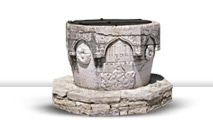
- Sečovlje Salt Pans - Dragonja River Valley
- Sv. Peter - Nova vas - Padna
- Pomjan - Nature Park: Karst Edge - Socerb
- Črni Kal - Osp - Kubed
- Momjan - Grožnjan - Pietrapelosa - Mirna
- Baštija - Kostanjica - Parenzana
- Oprtalj - Završje - Livade - Zrenj
- Istarske toplice - Motovun Forest - Višnjan
- Cave Mramornica - Feštini Kingdom - Cave Baredine
- Lim Bay - Kloštar - Kontija - Dvigrad
- Kanfanar - Bale - Palud - Vodnjan -Islands Brijuni - Fažana
- Svetvinčenat - Tinjan - Pićan - Gračišće
- Belaj - Šumber - Kožljak - Paz
- Čepićko Field - Kršan - Boljun Castle - Lupoglav
- Plomin - Kvarner Gulf - Brseč
- Nature park Učka - Mošćenice
Kanfanar - Bale - Palud - Vodnjan -Islands Brijuni - Fažana
Vodnjan
Traces of life in this area are observed already in prehistoric times: on Castelliere Hill above Vodnjan are the ruins of a prehistoric hill-fort.
When the Romans conquered Istria in 177 BC, land was given to the most meritorious soldiers. The area of Vodnjan was given to the soldier after whom the town was named Attinianum. A castle already existed at the time, a fortified and strategically important structure, with high, massive walls, watchtower and drawbridge. The ground plan of the one-time cistern and castle in today's main square is marked with white stone slates.
Within its historic core the town has preserved a unique medieval appearance with covered passages and narrow streets, meandering irregularly among houses and facades made of dressed stone, old streets of a specific style and a number of churches. In the 15th c. it had its statute and this manuscript has been preserved to this day. At that time, Vodnjan was a lively transit center with the seat of the Inquisition of Istria in St. Martin's Church. An interesting fact is that Vodnjan is the only town in Istria that was not plague-stricken.
West of the castle is Bettica Palace. South of the castle was the loggia, town market above which today stands Bradamante Palace from the 13th c. and the Church of Our Lady of Mount Carmel from the 17th c. Near the palace is the Church of St. Blaise, dominated by a 19th c. belfry, the tallest one in Istria (62 m).
The church keeps a collection of sacral art with numerous exhibits; the most precious are the non-decomposing bodies of saints, popularly known as the Vodnjan mummies. These are relics of St. Sebastian, St. Mary of Egypt and the best preserved among them, the body of St. Nikolosa from the 15th c., said to be the best preserved mortal remains in Europe.
The greater Vodnjan area, scattered with numerous characteristic kažuni, built in the dry stone technique, that marked property, testifies to the millennium when the population engaged in agriculture, especially olive and grape growing as the basis for their personal wealth and prosperity.



















